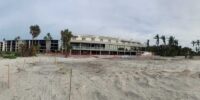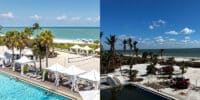Experience the Gulf Of Mexico From Sanibel Island’s Coastline
Although the Gulf of Mexico expresses a mixed melody of power and vastness, the rhythmic sounds of billions of tons of noble salt waters gently lapping and softly singing convey a comfortable, confident majesty.
Strolling along Sanibel Island’s coastline – outside of Sundial Beach Resort & Spa – nature’s strange coherence emerges: These are the rolling seas the ancients traveled, seeking the landlubber’s solace and the opportunity to propel fresh civilization into existence.
Our ancestors – time’s rugged sojourners – set foot here, on Sanibel Island, to plant some semblance of home, to create a fatherland. And it’s hardly any wonder. The riveting blue thrall of scenic waters rippling on faraway horizons paints mystic splendor in the human heart.
The act of watching – better yet, appreciating – the smooth rippling of Gulf waters communicates a facile sense of infinity in the human heart. This is the answer to the question of why? Why go to the sea? Why come to Sanibel Island? Why look into the power of prehistoric seas?
Sundial Offers Pristine View From Sanibel Island’s Coastline
Here it is – at Sundial Beach Resort & Spa – to behold.
The Gulf of Mexico lays nearly 1,700 miles of coastline along Florida, Alabama, Mississippi, Louisiana and Texas. On Mexico’s side, Gulf waters lap at more than 1,700 miles at the states of Tamaulipas, Veracruz, Tabasco, Campeche, Yucatan and Quintana Roo. It also wraps around Cuba on the southeast.
Thirty-three major rivers from 31 U.S. states flow into the Gulf of Mexico, which produces the Gulf Stream, a warm and very strong current flow from the Atlantic Ocean. The Mississippi River and the Rio Grande are major connectors with the Gulf on the north, and the Grijalva and Usumacinta Rivers on the south.
Oceanographers theorize plate tectonics, the shifting of earth’s crust, formed the Gulf more than 300 million years ago. The Gulf is about 615,000 square miles in size and about 930 miles wide with a floor of sedimentary rocks. It holds about 660 quadrillion gallons (660,000,000,000,000) of water. That’s 600,000 cubic miles.
The Florida Straits – between Florida and Cuba – introduce the Gulf of Mexico with the Atlantic Ocean. The Caribbean Sea taps into the Gulf through the Yucatan Channel between Mexico and Cuba. The narrow passages lessen the Gulf’s tidal ranges, thus the ocean water’s relative calm.
At Sundial Beach Resort & Spa, you have direct access to nature’s most fantastic show – miles of shoreline and the best shelling this side of our great blue planet. Enjoy the resort life while connecting with the Gulf of Mexico.
Explore Paradise at Sundial
But despite the long stretches of oceanic beauty, the center of it all – the great place – is Sanibel Island. This is where it all begins and ends: the barrier island’s white sand beaches and the picturesque views.
After exploring and examining Sanibel Island’s coastline and the area’s ancient history, relax and take advantage of modern luxury at Sundial Beach Resort and Spa’s beach-side or pool-side cabanas. One-, two- and three-bedroom accommodations provide kitchens and screened balconies. Sundial can customize your stay to suit your particular tastes.
Of course, your Sanibel Island stay at Sundial Beach Resort & Spa wouldn’t be complete without our wonderful resort amenities.
Behold, HydroGrid® tennis courts, state-of-the-art fitness center, five pools and Jacuzzi, kayaks and paddleboards, Sanibel Sea School and so much more.
How about sea turtle nesting season? It’s here. In abundance. At Sanibel Island. No promises that you’ll witness a sea turtle making its way on the beach for nesting, but Sundial guests were able to observe sundry sea turtle nests last year. Read our recent blog article about this.
Book your stay today.







